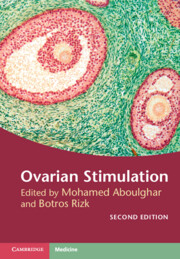Book contents
- Ovarian Stimulation
- Ovarian Stimulation
- Copyright page
- Dedication
- Contents
- Contributors
- About the Editors
- Foreword
- Preface to the first edition
- Preface to the second edition
- Section 1 Mild Forms of Ovarian Stimulation
- Section 2 Ovarian Hyperstimulation for IVF
- Chapter 6 GnRH Agonists for Ovarian Hyperstimulation
- Chapter 7 Role of GnRH Antagonist in Assisted Reproduction
- Chapter 8 Gonadotropins in Ovarian Stimulation
- Chapter 9 Egg Donation: Implications for Counseling Donor and Recipient, Donor Preparation, and Recipient Preparation
- Chapter 10 Progestin-Primed Ovarian Stimulation
- Chapter 11 Ovarian Stimulation in Poor Responders
- Section 3 Difficulties and Complications of Ovarian Stimulation and Implantation
- Section 4 Non-conventional Forms Used during Ovarian Stimulation
- Section 5 Alternatives to Ovarian Hyperstimulation and Delayed Transfer
- Section 6 Procedures before, during, and after Ovarian Stimulation
- Index
- References
Chapter 9 - Egg Donation: Implications for Counseling Donor and Recipient, Donor Preparation, and Recipient Preparation
from Section 2 - Ovarian Hyperstimulation for IVF
Published online by Cambridge University Press: 14 April 2022
- Ovarian Stimulation
- Ovarian Stimulation
- Copyright page
- Dedication
- Contents
- Contributors
- About the Editors
- Foreword
- Preface to the first edition
- Preface to the second edition
- Section 1 Mild Forms of Ovarian Stimulation
- Section 2 Ovarian Hyperstimulation for IVF
- Chapter 6 GnRH Agonists for Ovarian Hyperstimulation
- Chapter 7 Role of GnRH Antagonist in Assisted Reproduction
- Chapter 8 Gonadotropins in Ovarian Stimulation
- Chapter 9 Egg Donation: Implications for Counseling Donor and Recipient, Donor Preparation, and Recipient Preparation
- Chapter 10 Progestin-Primed Ovarian Stimulation
- Chapter 11 Ovarian Stimulation in Poor Responders
- Section 3 Difficulties and Complications of Ovarian Stimulation and Implantation
- Section 4 Non-conventional Forms Used during Ovarian Stimulation
- Section 5 Alternatives to Ovarian Hyperstimulation and Delayed Transfer
- Section 6 Procedures before, during, and after Ovarian Stimulation
- Index
- References
Summary
Oocyte donation (OD) is defined as the assisted reproduction technique (ART) in which a different woman than the one that will receive the resulting embryo provides the female gamete. Its diffusion has grown progressively due to both its excellent results and the increase of its indications [1]. According to the last European registers by the European Society of Human Reproduction and Embryology (ESHRE) in 2011, about half of the cycles of OD reported had been performed in Spain [2].
- Type
- Chapter
- Information
- Ovarian Stimulation , pp. 85 - 92Publisher: Cambridge University PressPrint publication year: 2022



